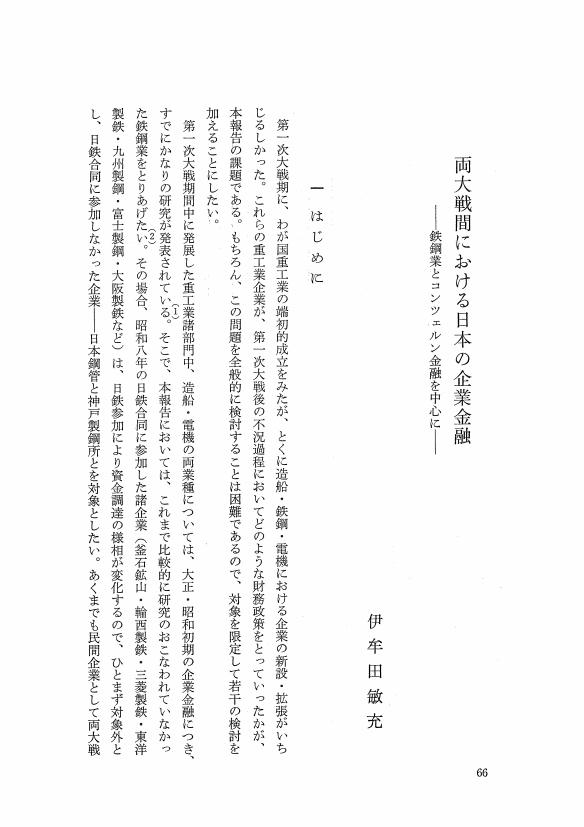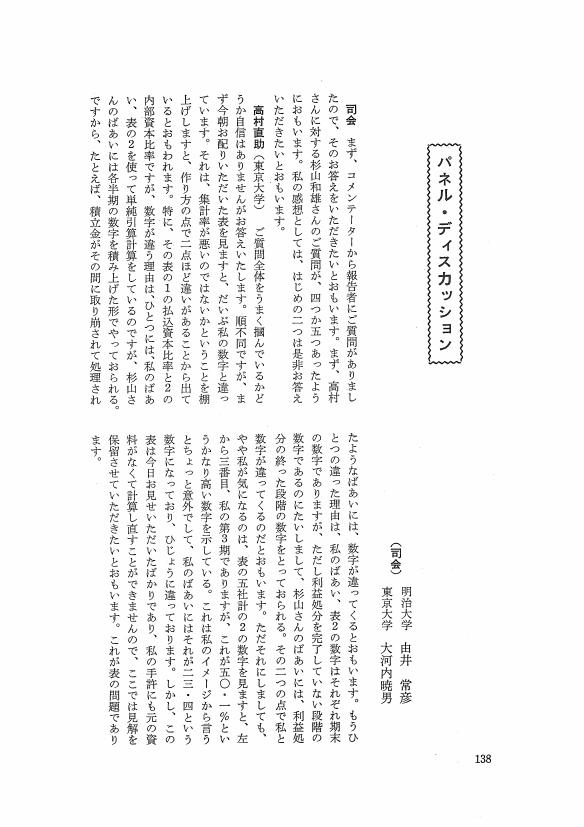1 0 0 0 OA 鉄鋼増産計画と企業金融 -産業開発五ケ年計画期の昭和製鋼所-
- 著者
- 大竹 愼一
- 出版者
- 経営史学会
- 雑誌
- 経営史学 (ISSN:03869113)
- 巻号頁・発行日
- vol.12, no.3, pp.45-64, 1978-06-30 (Released:2010-11-18)
1 0 0 0 OA 戦前昭和期三井三池炭礦における坑夫雇傭状況の推移
- 著者
- 畠山 秀樹
- 出版者
- 経営史学会
- 雑誌
- 経営史学 (ISSN:03869113)
- 巻号頁・発行日
- vol.12, no.3, pp.65-89, 1978-06-30 (Released:2010-11-18)
1 0 0 0 OA デュポンの国際経営戦略 -生産多角化から「多国籍」化への技術戦略-
- 著者
- 伊藤 裕人
- 出版者
- 経営史学会
- 雑誌
- 経営史学 (ISSN:03869113)
- 巻号頁・発行日
- vol.12, no.3, pp.90-104, 1978-06-30 (Released:2010-11-18)
1 0 0 0 OA 形成期イギリス綿紡績株式会社の経営体質
- 著者
- 米川 伸一
- 出版者
- 経営史学会
- 雑誌
- 経営史学 (ISSN:03869113)
- 巻号頁・発行日
- vol.12, no.2, pp.1-27,i, 1978-03-15 (Released:2010-11-18)
In the boom years of 1873-75 the Oldham people registered 76 cotton spinning companies, many of whose initiators were co-operaters in the local district. In this paper the author finds the basic facts of the companies in the formative period with special reference to their managerial aspects. Main sources are the documents preserved in the Public Record Office and Company Registration Office as well as the local newspapers published in the district.It seems significant that these so-called 'co-operative' companies had a distinct management ideology different from that of private companies. It was democracy. Stockholders of the companies were mostly the people associated with the cotton industry, especially the cotton spinners according to their occupation in the stockholders' list, many of whom were operative cotton spinners. Even the largest stockholders had two to three hundred stocks at most. Almost of all directors with twenty to fifty stocks had other jobs connected with cotton industry and in those days the articles of association strictly prohibited a company officer from taking a seat in the board. Strategic dicisions were usually made at the general meeting of stockholders after heated debates. In consequence, the meetings of the board tended to turn into a mere formality.Many of the managerial features of the companies seem to have stemmed from the experiences of the management of co-operative societies. One of the best examples is 'loans' in cotton spinning companies. An Act for Industrial and Provident Societies (1852) allowed the societies to have loan account with the interest rate less than six percent. The Sun Mill modelled upon the Rochdale Co-operative Cotton Manufacturing Society decided to have such loan accounts through the debates of the general meeting in the year of its foundation. The companies born in the following boom period followed the Sun Mill.
1 0 0 0 OA テイラーシステムとフランス産業 -その導入プロセスをめぐる一考察-
- 著者
- 原 輝史
- 出版者
- 経営史学会
- 雑誌
- 経営史学 (ISSN:03869113)
- 巻号頁・発行日
- vol.12, no.2, pp.28-48,ii, 1978-03-15 (Released:2010-11-18)
Shop Management, one of the most important works of F.W. Taylor, was translated into French by Henry Le Chatelier in 1907. The Principles of Scientific Management was also translated into French in 1912.The French business circles were so much interested in this new system of labour management that French scholars wrote many articles on this subject. Charles Fremont, for example, showed in his article of 1913 the origin of chronometry in France. According to him, it was in 1688 that the chronometry was already applied in the military work in France for the first time. He wanted to show French originality in chronometry.On the other hand, trade union leaders protested violently against the application. of this new system to French industries, so that the Taylor System was not easily accepted by French laborers.According to H. Le Chatelier, the application of Taylor System failed in France because the French society lacked the common sense (Le Bons Sens) which prevailed in U.S.A.
1 0 0 0 OA アメリカ電話電信会社における企業金融の展開過程
- 著者
- 山口 一臣
- 出版者
- 経営史学会
- 雑誌
- 経営史学 (ISSN:03869113)
- 巻号頁・発行日
- vol.12, no.2, pp.49-72,iii, 1978-03-15 (Released:2010-11-18)
Since the 1920s, AT & T followed virtually unchanging policies towards dividends and debt, that is, the company maintained a constant $ 9 per share dividend policy and an average debt ratio of about one third. This conservative financial policy was based on a belief that the best way for a regulated utility such as AT & T to attract and hold the goodwill and faith of a large number of small shareholders was through regular reasonable dividends and the long-run safety capital structure.To understand this belief and the present financial policies of AT & T, we must know its history. Then in this paper I tried to investigate the history of the AT & T's financial policies, in relation to their strategy for the national telephone monopoly and the management thoughts of their leaders.
1 0 0 0 OA イギリスにおける経営史研究の動向
- 著者
- シドニー ポラード
- 出版者
- 経営史学会
- 雑誌
- 経営史学 (ISSN:03869113)
- 巻号頁・発行日
- vol.12, no.2, pp.73-74, 1978-03-15 (Released:2010-11-18)
1 0 0 0 OA 西ドイツにおける経営史研究の状況
- 著者
- ヴォルフラム フィッシャー
- 出版者
- 経営史学会
- 雑誌
- 経営史学 (ISSN:03869113)
- 巻号頁・発行日
- vol.12, no.2, pp.75-77, 1978-03-15 (Released:2010-11-18)
1 0 0 0 OA アメリカにおける経営史研究の一動向
1 0 0 0 OA 一九七七年度ビジネス・ヒストリー・コンファレンスに出席して
- 著者
- 安岡 重明 川辺 信雄
- 出版者
- 経営史学会
- 雑誌
- 経営史学 (ISSN:03869113)
- 巻号頁・発行日
- vol.12, no.2, pp.84-91, 1978-03-15 (Released:2010-11-18)
1 0 0 0 OA 川崎正蔵の財産蓄積過程 -財閥化指向と挫折の理由-
- 著者
- 三島 康雄
- 出版者
- 経営史学会
- 雑誌
- 経営史学 (ISSN:03869113)
- 巻号頁・発行日
- vol.12, no.3, pp.1-21,i, 1978-06-30 (Released:2010-11-18)
S. Kawasaki, a famous ship-builder in Meiji era, founded the Tsukiji Shipyard (Tokyo) in 1827, for which he borrowed 30 thousands yen from the Ministry of finance. Masayoshi Matsukata, a chief officer in the Ministry of Finance, appointed Kawasaki to the privileged dealer of the sugar collected from Ryukyu Islands as tax. He could amass a great amount of commission in this sugar business and poured it to fill the deficit of his Tokyo and Kobe shipyards. He also managed to operate his business diversified into shipping, ships fittings, cotton spinning, machine-works and trading.Kawasaki bought the government shipyard in Kobe, and founded the Kawasaki Shipyard in 1887. But he suffered from heavy illness and retired from the presidency in 1896 when his company was reorganized into joint-stock company. After the retirement, Kawasaki bought a good deal of stocks of other companies, founded Kobe Kawasaki Bank in 1905, and also bought rice fields in Korea and forests in Miyazaki Pref., becoming a great land-owner around 1910. When he died in 1912, he thus left his private properties of about 5 millions yen, on the basis of which Kawasaki Sohonten (a stock-holding company) was founded in 1920, and the Kawasaki could developed as a modern zaibatsu fairly diversified into shipbuilding, shipping and aircraft manufacturing.
1 0 0 0 OA 一九世紀イギリスにおける製鉄業経営とランティエ化
- 著者
- 安部 悦生
- 出版者
- 経営史学会
- 雑誌
- 経営史学 (ISSN:03869113)
- 巻号頁・発行日
- vol.12, no.3, pp.22-44,ii, 1978-06-30 (Released:2010-11-18)
The Crawshays, a famous iron-maker family in South Wales, became inactive in the management of their iron-works in the middle of the 19th century. On the contrary, Crawshay (William II) rapidly increased his investment in securities such as Consols and domestic and foreign railway bonds, becoming in 1867 the greatest government stock holder in Great Britain. Why happened such a transition from industrial investment to investment in securities since 1850's?The general condition of Crawshay's business was very sound in 1850's. Some unfavourable factors, however, were forecast in the future of their business: first, the decline of production of iron ore in South Wales, a drastic change of the products from wrought iron to steel and the development of labour movement. In addition to these external factors, there was an unfavourable circumstance in Crawshay family itself: the lack of successor's talent for management. The reasons above mentioned seem to have been the key factors for the change from an ironmaster to a rentier.Crawshay thus suffered a great loss in iron-making in 1870's and eventually closed the iron-works. On the other hand, Crawshay's securities which amounted to over one million pounds brought the family tens of thousands pounds return a year. This article compares also Crawshay with the Dowlais Iron Company, and explains the difference in investment activity between the two rivals.
1 0 0 0 OA コメント1
- 著者
- 杉山 和雄
- 出版者
- 経営史学会
- 雑誌
- 経営史学 (ISSN:03869113)
- 巻号頁・発行日
- vol.12, no.1, pp.31-36, 1977-10-15 (Released:2009-11-06)
1 0 0 0 OA 第一次大戦前におけるランカシャー紡績業の資金調達
- 著者
- 荒井 政治
- 出版者
- 経営史学会
- 雑誌
- 経営史学 (ISSN:03869113)
- 巻号頁・発行日
- vol.12, no.1, pp.37-59, 1977-10-15 (Released:2009-11-06)
- 参考文献数
- 34
1 0 0 0 OA コメント2
- 著者
- 米川 伸一
- 出版者
- 経営史学会
- 雑誌
- 経営史学 (ISSN:03869113)
- 巻号頁・発行日
- vol.12, no.1, pp.60-65, 1977-10-15 (Released:2009-11-06)
1 0 0 0 OA 両大戦間における日本の企業金融 鉄鋼業とコンツェルン金融を中心に
1 0 0 0 OA コメント3
- 著者
- 小林 正彬
- 出版者
- 経営史学会
- 雑誌
- 経営史学 (ISSN:03869113)
- 巻号頁・発行日
- vol.12, no.1, pp.102-105, 1977-10-15 (Released:2009-11-06)
1 0 0 0 OA 両大戦間におけるアメリカの企業金融 電力と鉄鋼を中心に
- 著者
- 西川 純子
- 出版者
- 経営史学会
- 雑誌
- 経営史学 (ISSN:03869113)
- 巻号頁・発行日
- vol.12, no.1, pp.106-133, 1977-10-15 (Released:2009-11-06)
- 参考文献数
- 26
1 0 0 0 OA コメント4
- 著者
- 下川 浩一
- 出版者
- 経営史学会
- 雑誌
- 経営史学 (ISSN:03869113)
- 巻号頁・発行日
- vol.12, no.1, pp.134-137, 1977-10-15 (Released:2009-11-06)
1 0 0 0 OA パネル・ディスカッション
- 出版者
- 経営史学会
- 雑誌
- 経営史学 (ISSN:03869113)
- 巻号頁・発行日
- vol.12, no.1, pp.138-157, 1977-10-15 (Released:2009-11-06)














